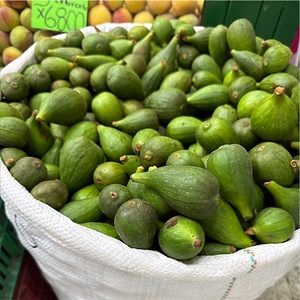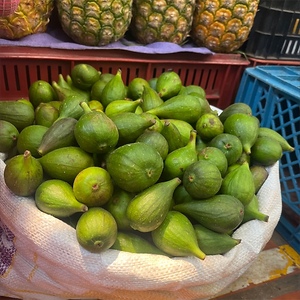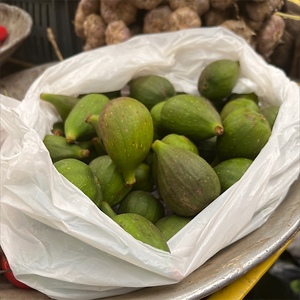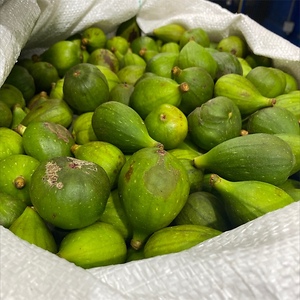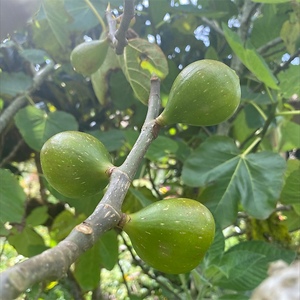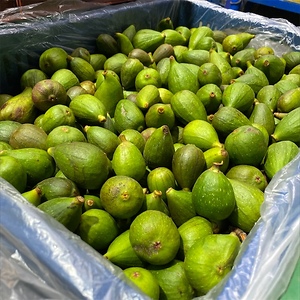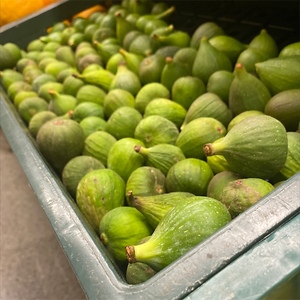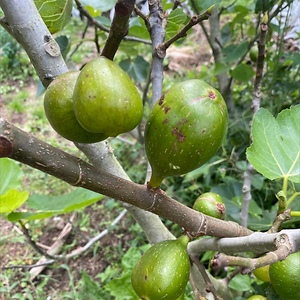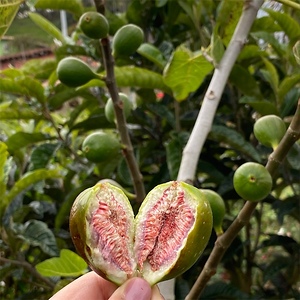


Brevas Figs
Estimated Inventory, lb : 0
Description/Taste
Brevas are small to medium, tear-drop shaped fruits that have a curved, bulbous base, subtly tapering to a pointed stem. The skin can range in textures from semi-smooth to wrinkled, depending on the specific variety, and may be ribbed with a firm, tough, and speckled appearance. Brevas can also be found with various skin colorings, emerging primarily green, sometimes developing purple, red, and brown hues. Underneath the surface, the white, pink, or purple flesh is soft, aqueous, and sticky with a jam-like consistency, containing many small, edible seeds forming a partially hollow, central cavity. Brevas will vary in taste, depending on the specific variety and region they are grown in, but primarily have a sweet and subtly tart, nutty, green flavor.
Seasons/Availability
Brevas are available in the late spring through early summer.
Current Facts
Brevas, botanically classified as Ficus carica, are an early crop of fruits found on fig trees, belonging to the Moraceae family. The fruits are also known as Breba, Taqsh, and Early figs, and there are many different varieties of fig trees that produce Brevas around the world. Brevas fruits appear in the spring on branches that did not produce figs from the previous main crop season. The fruits can be similar in appearance to main crop figs, or they can be found in differing colors, textures, and flavor. After Brevas are harvested, the next grouping of main crop figs will grow from newly sprouted branches in the mid to late summer. Brevas are considered to be rarer than main crop figs and are regarded as a specialty fruit. Edible Brevas are not guaranteed, as each tree will fluctuate in production, depending on the climate and variety, and some trees will produce fruits with a tart, astringent flavor. In culinary markets, especially in Spain and Colombia, Brevas are regarded as a delicacy due to their limited availability and are valued for their unpredictable, varying flavor.
Nutritional Value
Brevas are an excellent source of vitamins A and C, which are antioxidants that can help boost the immune system and reduce inflammation. The fruits are also a good source of fiber, which stimulates the digestive tract, and provides vitamin E, vitamin K, and minerals such as phosphorus, copper, potassium, magnesium, calcium, and iron.
Applications
Brevas can be eaten raw but are best suited for lightly cooked applications such as simmering and baking. The flavor of Brevas widely varies depending on the specific variety, with many fruits bearing a slightly tarter taste. To help counteract the sour flavors, Brevas are frequently simmered in a sugar-based syrup to develop a soft consistency and a sweet flavor. In Colombia, the syrup-soaked fruits, also known as dulce de Brevas, are commonly served over oatmeal, ice cream, cakes, or paired with cheeses such as queso fresco. Brevas can also be stuffed with cheese or dulce de leche, cooked into jams and compotes, baked into pastries, and depending on the sweetness, the figs can sometimes be tossed into salads. Brevas pair well with cheeses such as mozzarella, goat, pecorino, roquefort, and queso fresco, prosciutto, ham, fish such as smoked salmon, herbs such as mint, basil, thyme, rosemary, and sage, honey, and walnuts. The fresh fruits have a short shelf life and will keep for three days when stored in the refrigerator.
Ethnic/Cultural Info
Brevas are traditionally eaten during the Fiesta de San Juan, also known as Saint John’s Eve and the Festival of Midsummer’s Eve. The multi-day event was initially created to recognize the birthday of John the Baptist on June 24th, but in the modern-day, the festival has blended with other ancient traditions and is celebrated among many different religious groups. In Alicante, Spain, the festival is centered around large bonfires that are built from handmade art pieces, furniture, and old wood. The bonfires represent protection against evil spirits, and the townspeople gather together to drink, eat, and watch young men jump over the fires. During the festival, Brevas are consumed daily as a celebratory sweet and are considered to be a delicacy. Brevas also come into season in the early summer, coinciding with the summer solstice, and have become a symbol of the warmer summer days to come.
Geography/History
Figs are native to Western Asia and are considered to be one of the most widespread species found around the world. The trees are easily transported through cuttings and were first introduced into the Mediterranean in ancient times, where the Greeks and Romans widely cultivated them. In the early 16th century, Spanish missionaries and explorers brought the fruits to the New World, and later in the 18th century, European colonization further expanded the genetic diversity of fig varieties in North America through extensive cultivation and breeding. Today Brevas are found growing on multiple types of fig trees around the world, and the fruits, when in season, are primarily sold fresh at local markets throughout Asia, Europe, Australia, North America, and South America.
Recipe Ideas
Recipes that include Brevas Figs. One
| My Kitchen in Spain |
|
Salad with Grilled Chicken and Figs |
| A Quirky Lifestyle |
|
Colombian Carmel Stuffed Figs |



